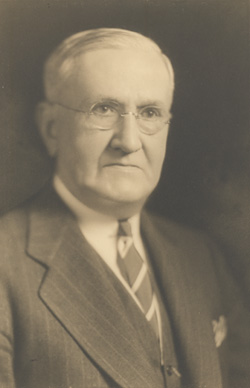Introduction
One of the most interesting rare book collections housed at the Bernard Becker Medical Library is the Robert E. Schlueter Paracelsus Collection. Dr. Robert Schlueter (1872-1955) was a graduate of the St. Louis College of Pharmacy and the Missouri Medical College who later taught surgery at Washington University. Like many other medical professionals, he was also a bibliophile. In 1909 and 1910 he traveled to Europe in order to study surgery, pathology, and medical history. This was also when he began purchasing rare books. Over the years he amassed an extraordinary collection of over 400 volumes containing the writings of the iconoclastic 16th century physician-alchemist Paracelsus, his contemporaries, and his followers.
Some of the most fascinating works in Schlueter’s collection are illustrated prophecies. Prophetic works began to be printed as soon as Gutenberg developed his system of printing with movable metal type. One of the earliest works to come off his press was the so-called Sibyllenbuch fragment. This fragment is part of a longer 14th century poem in which a sibyl visits King Solomon and offers insight into future events that she has learned of in the heavens. Gutenberg may have printed this work as early as c.1452-1453, predating the Gutenberg Bible by a few years. His early faith in a market for prophetic literature proved to be well-founded, as from 1470 onward annual practicas – short tracts containing predictions for the upcoming year – became an increasingly popular genre.
Works of prophecy can be both reflections of the time in which they are produced and society’s attempts to interpret societal changes. It is therefore not surprising that the centuries leading up to the German Reformation saw the publication of numerous prognostications with apocalyptic overtones. The late medieval period, particularly the 14th and 15th centuries, saw a series of calamities that had a deep impact on the common psyche. In the middle of the 14th century the Black Death ravaged the European continent and killed a significant portion of the population, and from 1378-1417 the Catholic Church was divided between rival popes, resulting in a great crisis of confidence among Christians. Compounding these disasters, in 1453 Constantinople fell to the Ottoman Empire, marking the end of the Roman Empire and leaving the eastern frontiers of Christendom open to attack.
Prophecies gave people a way to try and understand these crises. Medieval prophecies written (or allegedly written) by religious visionaries such as Saint Brigitte of Sweden, Joachim of Fiore, and Brother Reinhardt were swiftly disseminated by the new technology of printing, along with the works of a new wave of prophets. Regardless of their origin, these prophecies were often filled with familiar tropes, the most popular of which were the corruption of the papacy, the appearance of an angelic pope (the pastor anglicus), the Pope and/or the Turks as the Antichrist, and the appearance of a Last Emperor (often seen by the Germans as Frederick I) who would defeat the enemies of Christianity and usher in a time of prosperity.
The preoccupation with when the Antichrist would begin his assault is understandable in the context of the medieval and early modern perceptions of time. The people of Reformation-era Germany believed in a Christian cosmology: one in which the world had been created by God, and would be ended by God at a set point in time. Unsurprisingly, people were very concerned with when exactly the Day of Reckoning would come. For the answer to this all-important question, they often turned to religious texts. One of the most important sources was the Book of Daniel, in which the prophet Daniel had a vision of four beasts that represented four worldly empires. Many Protestant theologians believed that they were currently living in the time of the fourth empire, and the foretold end was therefore imminent. Another key source was the Talmudic Prophecy of Elias, which divided the history of the world into three distinct eras lasting 2000 years each: the time before they received the Law, the time of the Law, and the time of the messiah. Lutheran prophets attempted to correlate events in the Bible with the timeline of these three ages and figure out how close they were to the end of the final age, which Protestants determined to be in their own time. For Germans in the Reformation period, the end of days was a fixed point in time that was rapidly approaching.
While prophetic works were extremely popular in the 16th century and the beginning of the 17th century, as the century progressed there was something of a backlash against them. By the 1620s the number of different prophecies in circulation compounded by the number of false predictions regarding the last day began to undermine their credibility. The outbreak of the Thirty Years’ War (1618-1648) initially spurred interest in the imminent apocalypse and the appearance of the Last Emperor, but by the middle of the century apocalypticism was falling out of favor. The end of days failed to come, and determining how to govern an existing Christian society became more important than anticipating an apocalypse that failed to materialize.
